Excerpts from Jim Conrad's
Naturalist Newsletter
from the November 27 2016 Newsletter issued from Rancho Regenesis in the woods ±4kms west of Ek Balam Ruins; elevation ~40m (~130 ft), N20.876°, W88.170°; north-central Yucatán, MÉXICO
AIR POTATO EDIBLE BULBILS
One of the most surprising plants found growing at the rancho is the one shown below:
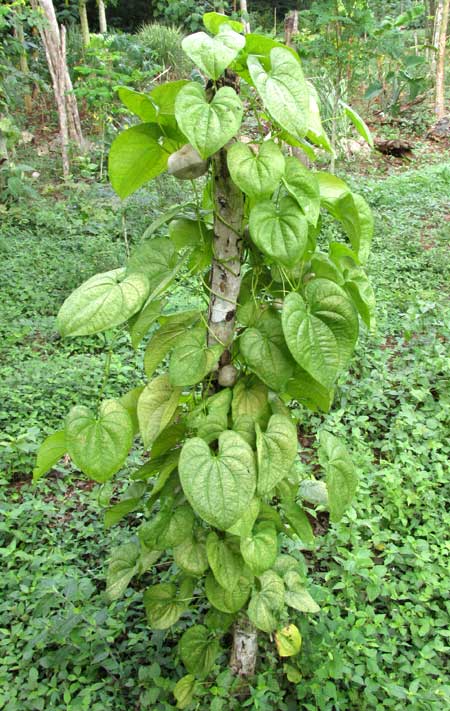
From the first glance it was clear that this was a kind of yam, a member of the viny Yam Family, the Dioscoreaceae. This is one group of plants in which the leaves are diagnostic, not just the flowers. Our rancho plant's typical Yam Family leaf is shown below:
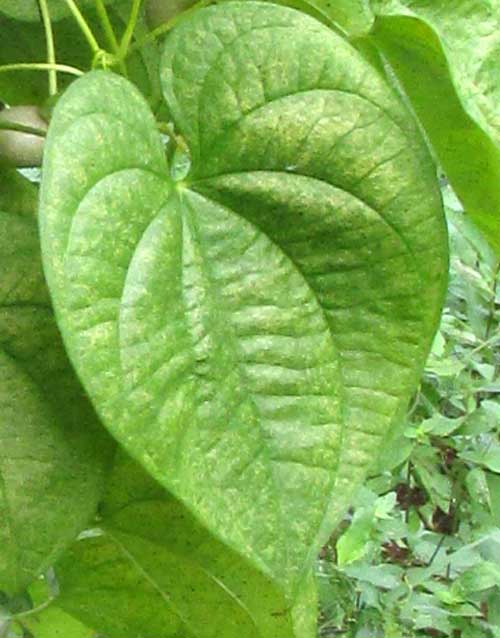
What's distinctive is the way the leaf's secondary veins connect the primary veins radiating from the sinus's base, forming more or less rectangular "windows." Except for these rectangles, the leaf could belong to a morning glory.
And what's so surprising about our plant is shown below:
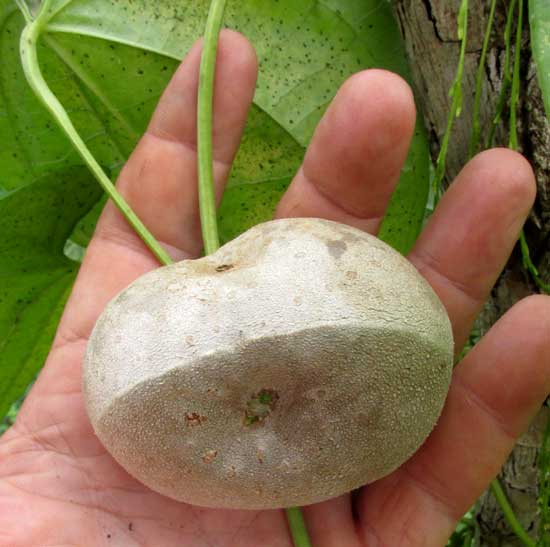
That angular, potato-like thing is attached to the stem at head level. We think of the Yam Family's yams as subterranean root tubers, but the thing in our picture is not a tuber, but rather an aerial "bulbil," and it's edible.
In English our plant usually is known as the Air Potato, because of those bulbils. It's DIOSCOREA BULBIFERA, from tropical Asia, and it also produces regular underground tubers.
In our picture, notice that our bulbil has sharp edges. Those edges are important because in some places Air Potatoes have gone wild, also produce bulbils, but they're spherical and their edibility is questionable. In fact, several Air Potato cultivars are in circulation and from what I read some produce bulbils that are variously toxic. However, since our plant was bought with the understanding that its bulbils are edible, and general consensus seems to be that cultivar bulbils with sharp edges are edible, I'm looking forward to eating it. Bulbils on plants receiving plenty of sunshine and water can be several times larger than the one in our picture.
Our vine also produces an underground tuber, but there's debate and confusion as to whether those are edible. Probably they are, but only after special preparation, which may go as far as crushing the tuber, drying it, baking it, leaching the powder, and then using it. A good review of the Air Potato tuber toxicity problem is provided at Green Deane's at Eat-the-Weeds website.
from the April 23, 2017 Newsletter issued from Rancho Regenesis in the woods ±4kms west of Ek Balam Ruins; elevation ~40m (~130 ft), N20.876°, W88.170°; north-central Yucatán, MÉXICO
AIR POTATO BULBILS SPROUTING
Back in November when the above entry was made I'd planned to eat some bulbils but when I cut into them they were greenish beneath their brown skin and hard all the way through. My impression was that they were immature and, since on the Internet there was some ambiguity about whether they were toxic or not, I let them pass. A few months later I cut into them again and they were still greenish and hard. Also, I assumed that the bulbils when planted would sprout and produce new vines, but I couldn't find confirmation of that, and after a few months there was no sign of sprouting. I more or less gave up on them and tossed them in a bucket of compost, thinking that either they'd sprout or become part of the compost.
Last week when I returned from the Kentucky trip I was gratified to find nearly all the bulbils sprouting, one of them shown below:
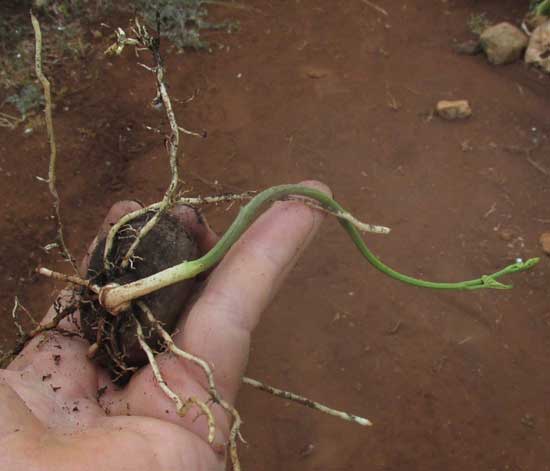
Not only were the bulbils sprouting, but they were doing so with vigor. Moreover, last November I'd planted some of the largest, most mature-looking ones, watered them for about three months, and when nothing developed stopped watering them. Even those, now residing in late-dry-season, hard-packed dust, were sprouting.
Therefore, now we know that Air Potato bulbils do sprout to produce new plants, but they seem to need three or four months of rest before doing so, and whether they're watered or not during their resting period doesn't seem to matter.
from the October 1, 2017 Newsletter issued from Rancho Regenesis in the woods ±4kms west of Ek Balam Ruins; elevation ~40m (~130 ft), N20.876°, W88.170°; north-central Yucatán, MÉXICO
EATING AIR POTATOES
Last year our vines' aerial potatoes weren't so impressive, because they hadn't been taken care of. This year I planted last year's small bulbils in soil into which I'd mixed composted manure, and I watered the vines regularly. Now the vines are 20ft long (6m), still growing fast, and already producing angular, aerial bulbils much larger than the ones photographed last year. One of this year's air potatoes is shown below:
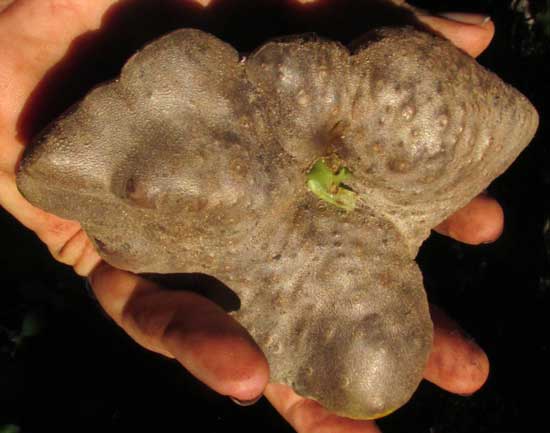
This bulbil was harder than a regular potato -- so hard I wondered whether it would be edible after a fair boiling. To encourage the softening process I cut the bulbil into sections about finger thick, before boiling them in water for about 20 minutes.
The pieces turned out as soft as a well boiled potato. However, it didn't taste like a potato, or anything else; it was basically tasteless carbohydrate, but its "empty calories" were filling. The Maya workers here say they like to eat it with honey, or salt. The salt is understood to be mixed with dried hot chili pepper. A Northerner probably would like it with butter or yogurt.
In terms of gardening, the vines take up a lot of space to produce a fairly modest crop of air potatoes. If you have a place at the edge of the garden where the vines can climb high into trees or run along or cross the fence and scramble among bushes, that might work. Otherwise, I think of Air Potato vines as mainly a novelty. Other crops produce a lot more food while taking up less space.
from the November 5, 2017 Newsletter issued from Rancho Regenesis in the woods ±4kms west of Ek Balam Ruins; elevation ~40m (~130 ft), N20.876°, W88.170°; north-central Yucatán, MÉXICO
AIR POTATO #2
At the rancho we also grow Air Potato vines that are much closer to the wild form, with smaller, rounder bulbils, such as those shown below:
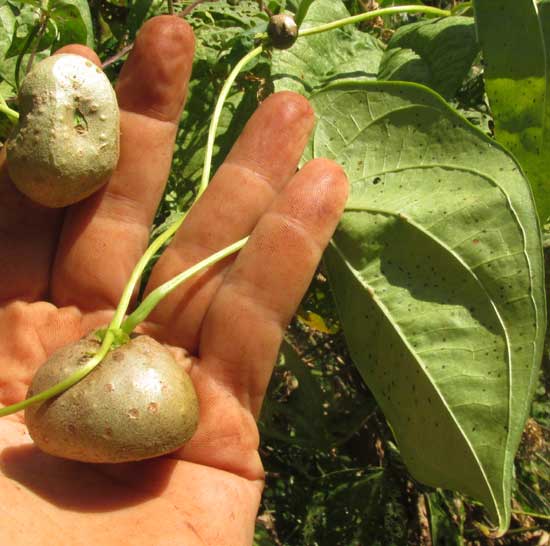
The wild form's bulbils contain the steroid diosgenin, and can be poisonous. This week before I remembered that, I collected some smallish, roundish bulbils such as those in the above picture, boiled them for about an hour, and ate them, with no ill effects. They tasted like regular boiled potatoes, though with a certain oily flavor. But even these bulbils were the product of a cultivar, for wild-type bulbils are even smaller than these. So, I'd still hesitate to eat many bulbils of the truly wild form, which often is encountered in North America as a weedy vine.